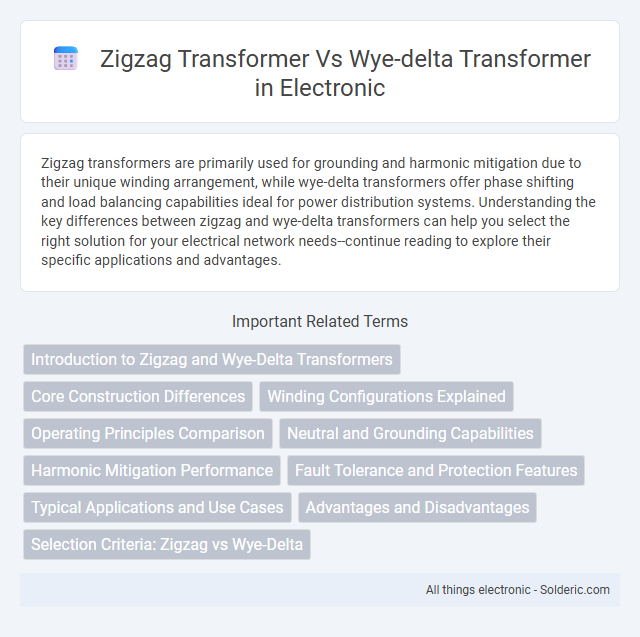Zigzag transformers are primarily used for grounding and harmonic mitigation due to their unique winding arrangement, while wye-delta transformers offer phase shifting and load balancing capabilities ideal for power distribution systems. Understanding the key differences between zigzag and wye-delta transformers can help you select the right solution for your electrical network needs--continue reading to explore their specific applications and advantages.
Comparison Table
| Feature | Zigzag Transformer | Wye-Delta Transformer |
|---|---|---|
| Connection Type | Zigzag (interconnected windings) | Primary: Wye (star), Secondary: Delta |
| Neutral Availability | Provides neutral point | Neutral not available on Delta side |
| Purpose | Harmonic reduction, grounding, unbalanced load handling | Phase shifting, load balancing, motor starting |
| Phase Shift | 0deg or minimal phase shift | 30deg phase shift between primary and secondary |
| Harmonics Handling | Effective suppression of triplen harmonics | Limited harmonic suppression, mainly for load balancing |
| Common Applications | Grounding transformers for ungrounded systems, harmonic mitigation | Distribution transformers, motor loads, phase conversion |
| Cost | Moderate to high due to winding complexity | Moderate, simpler winding configuration |
Introduction to Zigzag and Wye-Delta Transformers
Zigzag transformers feature windings connected in a zigzag pattern, providing effective grounding and harmonic mitigation in power systems. Wye-delta transformers consist of a wye-connected primary and delta-connected secondary winding, offering voltage transformation with phase shifting capabilities to balance loads. Your choice between them depends on specific applications like grounding, load balancing, and harmonic reduction requirements.
Core Construction Differences
The zigzag transformer features a unique core construction with three identical limbs where each limb carries part of two windings, enabling phase shift and grounding capabilities. In contrast, a wye-delta transformer consists of separate wye (star) and delta winding groups typically placed on distinct limbs of the core to facilitate different connections and improve fault tolerance. Your choice between these types depends on the specific grounding, phase shifting, and harmonics management requirements dictated by their core configurations.
Winding Configurations Explained
Zigzag transformers utilize windings arranged in a zigzag pattern across the three phases, providing excellent neutral grounding and minimizing harmonic currents. Wye-delta transformers have windings connected in a star (wye) on one side and a delta on the other, balancing phase voltages and facilitating phase shift between primary and secondary. The zigzag configuration is preferred for grounding and harmonic suppression, while wye-delta connections are commonly used for load balancing and voltage transformation in three-phase systems.
Operating Principles Comparison
Zigzag transformers utilize interconnected windings that create a neutral point ideal for grounding and harmonic mitigation, while wye-delta transformers feature a primary wye connection and secondary delta connection to facilitate phase shift and unbalanced load management. The zigzag transformer operates by splitting each phase winding into two equal parts linked in a specific zigzag pattern, providing excellent zero-sequence current handling for system stability. In contrast, the wye-delta transformer enables phase displacement between primary and secondary sides, supporting applications requiring load balancing and fault current reduction in three-phase power systems.
Neutral and Grounding Capabilities
Zigzag transformers provide superior neutral grounding by offering low-resistance paths for ground fault currents, enhancing system stability and reducing transient overvoltages. Wye-delta transformers create a neutral point on the wye side but typically have limited grounding capabilities, often requiring external grounding resistors or reactors. Zigzag configurations are preferred in applications demanding solid neutral grounding and effective suppression of zero-sequence currents.
Harmonic Mitigation Performance
Zigzag transformers excel in harmonic mitigation by effectively canceling triplen harmonics due to their unique winding configuration, which reduces neutral current distortion and enhances power quality. Wye-delta transformers also mitigate harmonics by circulating zero-sequence currents within the delta, thus limiting harmonic propagation back to the source but may be less effective against certain triplen harmonics compared to zigzag types. Choosing the appropriate transformer for your system significantly impacts harmonic performance, with zigzag transformers offering superior suppression of harmonic distortions in sensitive applications.
Fault Tolerance and Protection Features
Zigzag transformers provide superior fault tolerance by effectively handling unbalanced loads and suppressing triplen harmonics, which reduces neutral point displacement during ground faults. Wye-delta transformers offer inherent protection through phase shift and isolation, minimizing fault currents and enhancing system stability during line-to-line faults. The zigzag configuration is particularly advantageous for ground fault detection, while wye-delta transformers excel in mitigating transient overvoltages and maintaining load continuity under fault conditions.
Typical Applications and Use Cases
Zigzag transformers are commonly used for grounding and neutral grounding in power distribution systems, effectively mitigating harmonics and unbalanced loads. Wye-delta transformers are typically employed in industrial power setups to provide phase shift for motor loads and facilitate load balancing across three-phase systems. Both transformers play critical roles in enhancing system stability and reliability in electrical networks.
Advantages and Disadvantages
Zigzag transformers offer superior harmonic suppression and better grounding capabilities, making them ideal for systems requiring neutral grounding and reducing triplen harmonics. Wye-delta transformers provide phase shift benefits and simpler construction, which enhances load balancing and helps in isolating faults in three-phase systems. Your choice depends on the need for harmonic mitigation versus phase shifting and fault tolerance in electrical distribution networks.
Selection Criteria: Zigzag vs Wye-Delta
Selection criteria for Zigzag vs Wye-Delta transformers hinge on application requirements and system characteristics. Zigzag transformers excel in grounding and harmonic mitigation due to their unique winding configuration, making them ideal for neutral grounding in unbalanced loads. Wye-Delta transformers are preferred for applications requiring phase shift for load balancing and harmonic reduction in three-phase power systems.
zigzag transformer vs wye-delta transformer Infographic

 solderic.com
solderic.com